Did you know that over 60% of households have unused glassware perfect for creative projects? You can transform these items into stunning terrariums without breaking the bank. Start with the basics of green living by repurposing jars or vases, about 6-8 inches tall, for mini ecosystems. Curious about turning everyday objects into decor? Stick around to explore practical, budget-friendly ideas for your space.
Contents
- 1 Repurpose Household Items for Unique Layers
- 2 Use Pebbles and Stones From Your Backyard
- 3 Craft Miniature Decor With Polymer Clay
- 4 Incorporate Thrifted Glassware as Containers
- 5 Add Color With Painted Rocks
- 6 Create Depth With Moss From Nature
- 7 Utilize Twigs and Branches for Structure
- 8 Design With Recycled Plastic Bottle Caps
- 9 Enhance With Handmade Paper Cutouts
- 10 Highlight With Affordable Fairy Lights
Repurpose Household Items for Unique Layers
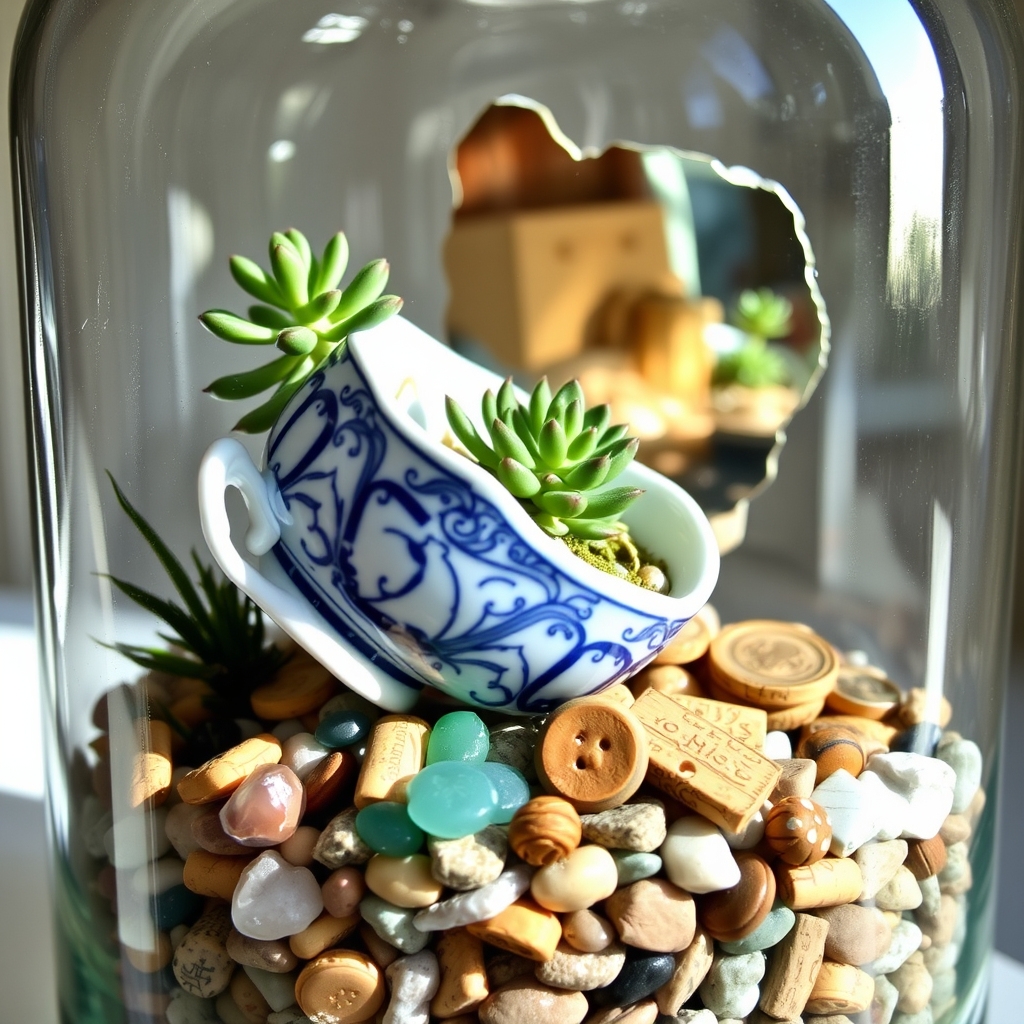
Repurposing household items for terrarium decor is a creative and sustainable way to add unique layers to your miniature ecosystem. Everyday objects like old glass jars, broken pottery, or even small figurines can be transformed into eye-catching elements that enhance the visual appeal of your terrarium. This approach not only reduces waste but also allows you to personalize your terrarium with items that hold sentimental value or reflect your style.
Consider using items like wine corks to create tiny platforms or barriers, or repurpose cracked teacups as miniature planters within the terrarium for a whimsical touch. Small pebbles from a garden or beach trip can serve as a natural base layer, while bits of colored glass or marbles can add pops of color and texture. By layering these repurposed materials thoughtfully, you can create depth and interest, turning your terrarium into a storytelling piece that showcases both nature and your creativity.
Experimenting with different household items also encourages resourcefulness, as you might discover unexpected uses for things you’d otherwise discard. For instance, a broken piece of mirror can reflect light and make the terrarium appear larger, while old buttons or beads can mimic natural elements like stones or dewdrops. This method of decorating guarantees that each terrarium is one-of-a-kind, blending functionality with personal flair.
Use Pebbles and Stones From Your Backyard
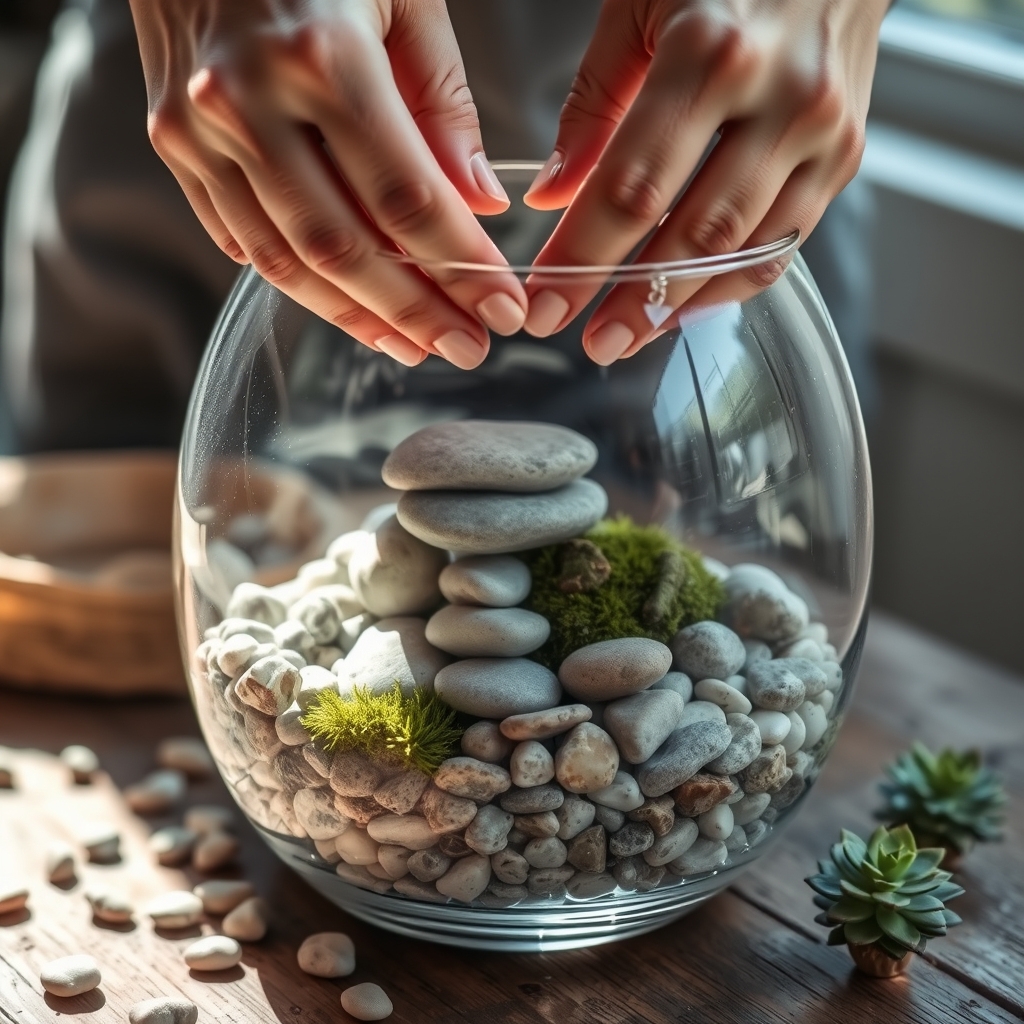
Incorporating pebbles and stones from your backyard into a terrarium is a fantastic way to add a natural, rustic charm while keeping costs low. These materials are often readily available and can bring a unique, personal touch to your miniature ecosystem. Before using them, make sure the stones are clean by rinsing them thoroughly with water to remove dirt, debris, or any potential contaminants that could harm your plants or animals.
Start by selecting a variety of sizes, shapes, and colors of pebbles and stones to create visual interest and texture within your terrarium. Smaller pebbles can be used as a base layer for drainage, helping to prevent root rot by keeping excess water away from plant roots. Larger stones can serve as focal points or natural dividers, adding structure and depth to the design.
For an added creative twist, consider arranging the stones to mimic natural landscapes, such as riverbeds or rocky hillsides, depending on the theme of your terrarium. You can also pair them with other natural elements like driftwood or moss to enhance the overall aesthetic. Using backyard pebbles and stones not only recycles materials but also connects your terrarium to the environment right outside your door.
Craft Miniature Decor With Polymer Clay
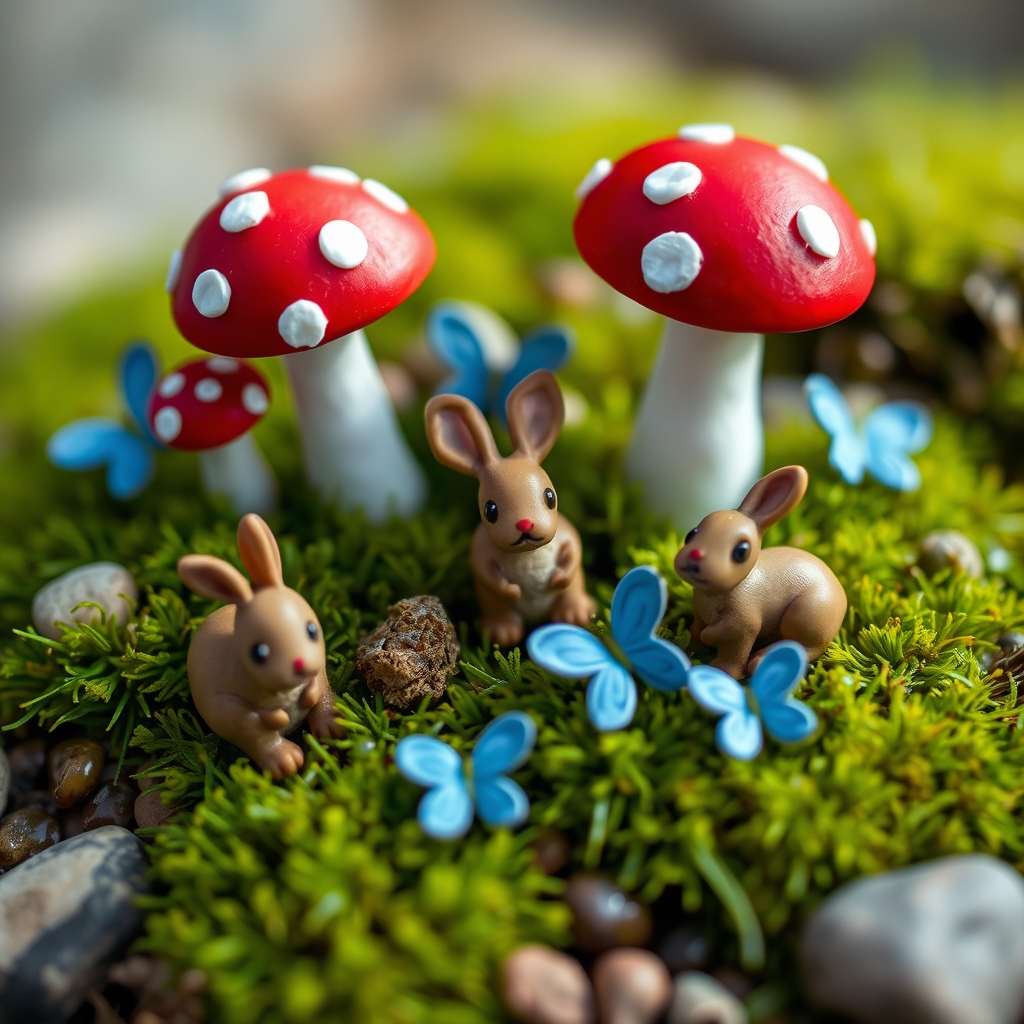
Crafting miniature decor with polymer clay is a fantastic way to add personalized and intricate details to your terrarium. Polymer clay is a versatile, easy-to-use material that can be shaped into almost anything, from tiny rocks and mushrooms to small animals or fairy-tale elements. Once baked, it hardens into a durable form, making it perfect for long-lasting terrarium decorations that can withstand the humid environment.
To get started, choose a theme or specific elements you want to create, such as a whimsical forest scene with toadstools or a desert landscape with cacti. Use small tools like toothpicks or sculpting tools to add fine details, and experiment with blending colors for a realistic effect. After shaping your designs, bake them according to the clay manufacturer’s instructions, usually at a low temperature for a short time, to set the form. Once cooled, place these miniatures strategically in your terrarium to enhance its visual appeal and create a unique, handcrafted look.
Polymer clay decor not only adds a personal touch but also allows for endless creativity, as you can craft seasonal themes or update your terrarium’s look over time. It’s an affordable and fun way to bring your miniature world to life, making your terrarium a true reflection of your imagination.
Incorporate Thrifted Glassware as Containers
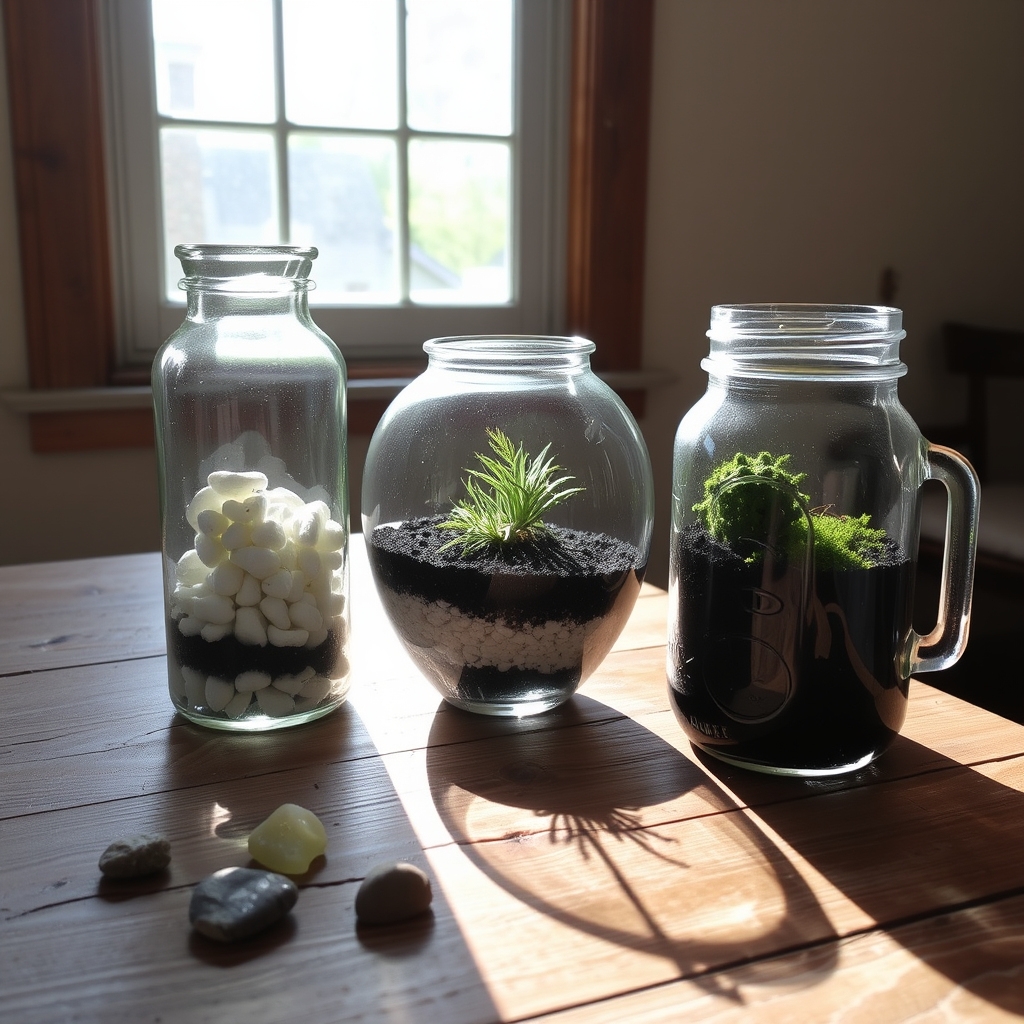
Incorporating thrifted glassware as containers is a creative and budget-friendly way to enhance the aesthetic of your terrarium. Thrift stores often have a variety of unique glass items, such as old vases, jars, candle holders, or even quirky bowls, that can serve as charming homes for your miniature ecosystems. These pieces add a touch of vintage charm and personality to your terrarium setup, making each one a one-of-a-kind display.
When selecting thrifted glassware, look for containers with interesting shapes or textures that can complement the plants and decor inside. Make sure the glass is clean and free of cracks to provide a safe environment for your plants. You can layer the bottom with pebbles for drainage, add a layer of activated charcoal to keep the environment fresh, and then top it with soil suitable for your chosen plants, such as succulents or moss.
Using thrifted glassware not only saves money but also promotes sustainability by repurposing items that might otherwise go unused. Mix and match different sizes and styles to create a cohesive yet eclectic look, grouping them together on a shelf or table for a stunning visual impact. This approach allows you to experiment with various designs while keeping your terrarium project environmentally friendly and uniquely yours.
Add Color With Painted Rocks
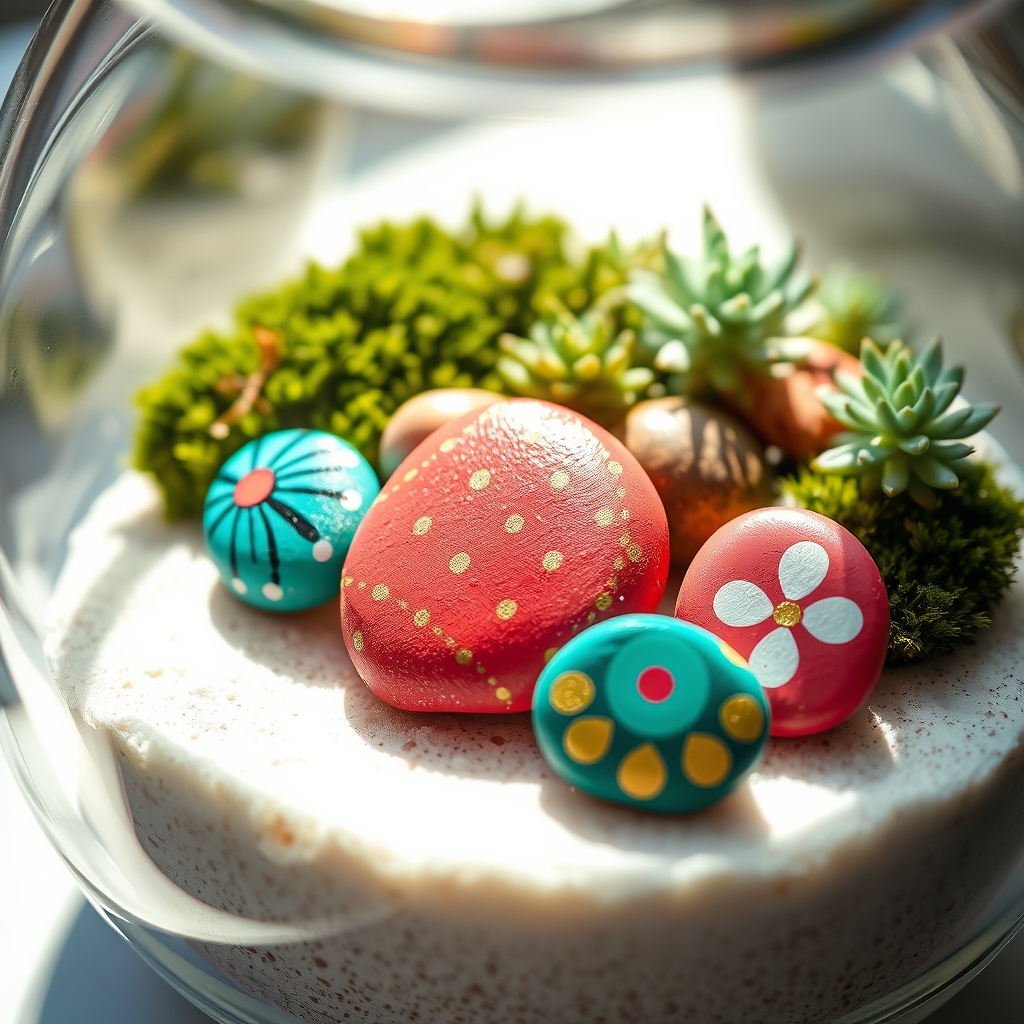
Adding color to your terrarium with painted rocks is a simple and creative way to enhance its visual appeal. Rocks can be transformed into vibrant decor pieces by using acrylic paint, which adheres well to their surface and comes in a wide variety of colors. You can paint them in solid hues, create intricate patterns, or even draw tiny designs like animals or plants to match the theme of your terrarium.
To get started, collect smooth, clean rocks from your garden or a craft store, and make sure they are free of dirt or debris before painting. Use a small brush for detailed work or a sponge for broader coverage, and consider sealing the paint with a clear varnish to protect it from moisture in the terrarium environment. Place the painted rocks strategically among the plants or along the edges to create focal points that draw the eye.
This budget-friendly decor idea allows for endless customization, letting you refresh the look of your terrarium whenever you want. Painted rocks can also serve as labels for different plant sections if you write names or symbols on them, combining functionality with style.
Create Depth With Moss From Nature
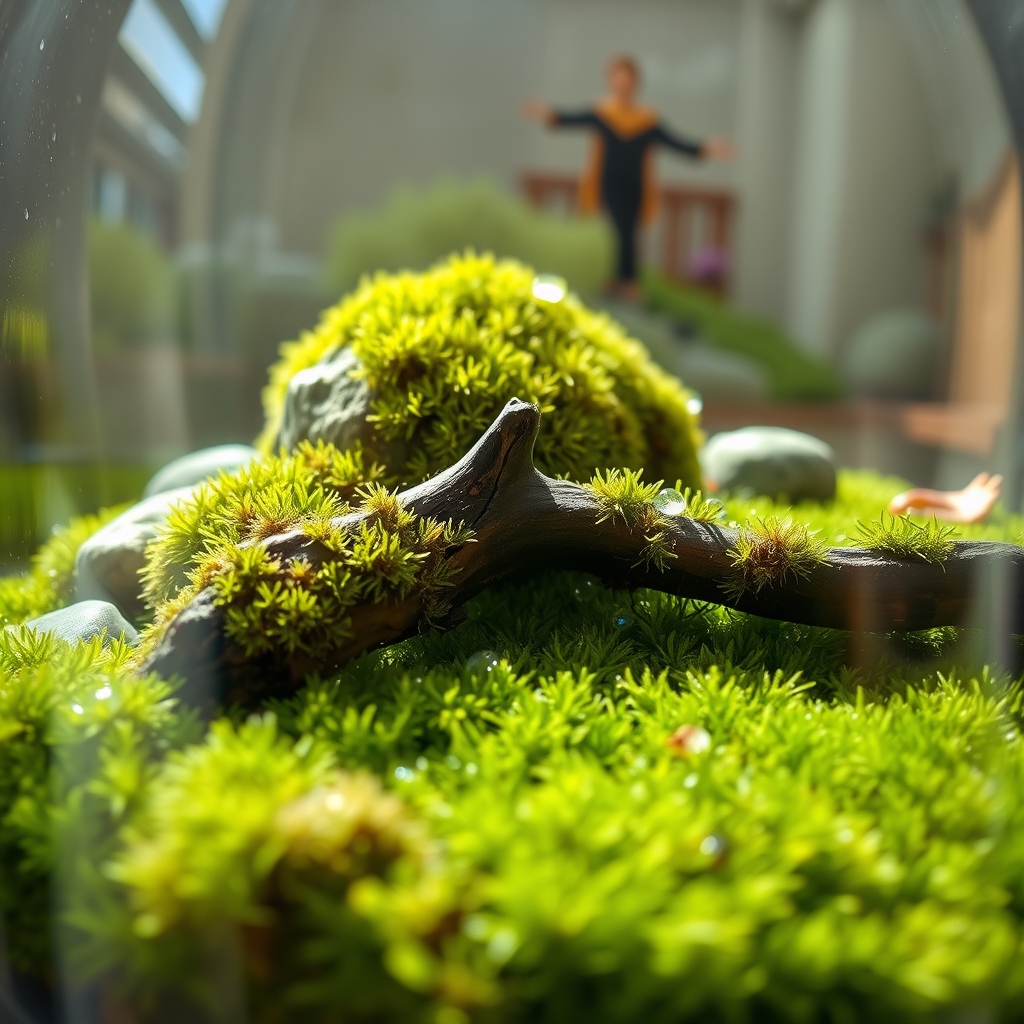
Creating depth in a terrarium using moss from nature is a fantastic way to add a lush, organic feel to your miniature ecosystem. Moss, with its varied textures and shades of green, can mimic a forest floor or a rolling hillside when strategically placed. Collecting moss from local woodlands or damp areas (with permission and care for the environment) allows you to bring a piece of the natural world into your terrarium, enhancing its realism and depth.
To achieve this effect, layer different types of moss at varying heights within the terrarium. For instance, place cushion moss on elevated areas or rocks to create a sense of elevation, while sheet moss can cover the base to represent a lower ground level. This contrast in height and texture tricks the eye into perceiving a more expansive, three-dimensional landscape.
Additionally, moss can be used to soften hard edges of rocks or driftwood, blending these elements into the environment for a more cohesive look. Make sure the moss stays moist by misting it regularly, as this will maintain its vibrant color and prevent it from drying out. By thoughtfully arranging moss, you can transform a simple glass container into a fascinating, multi-dimensional natural scene.
Utilize Twigs and Branches for Structure
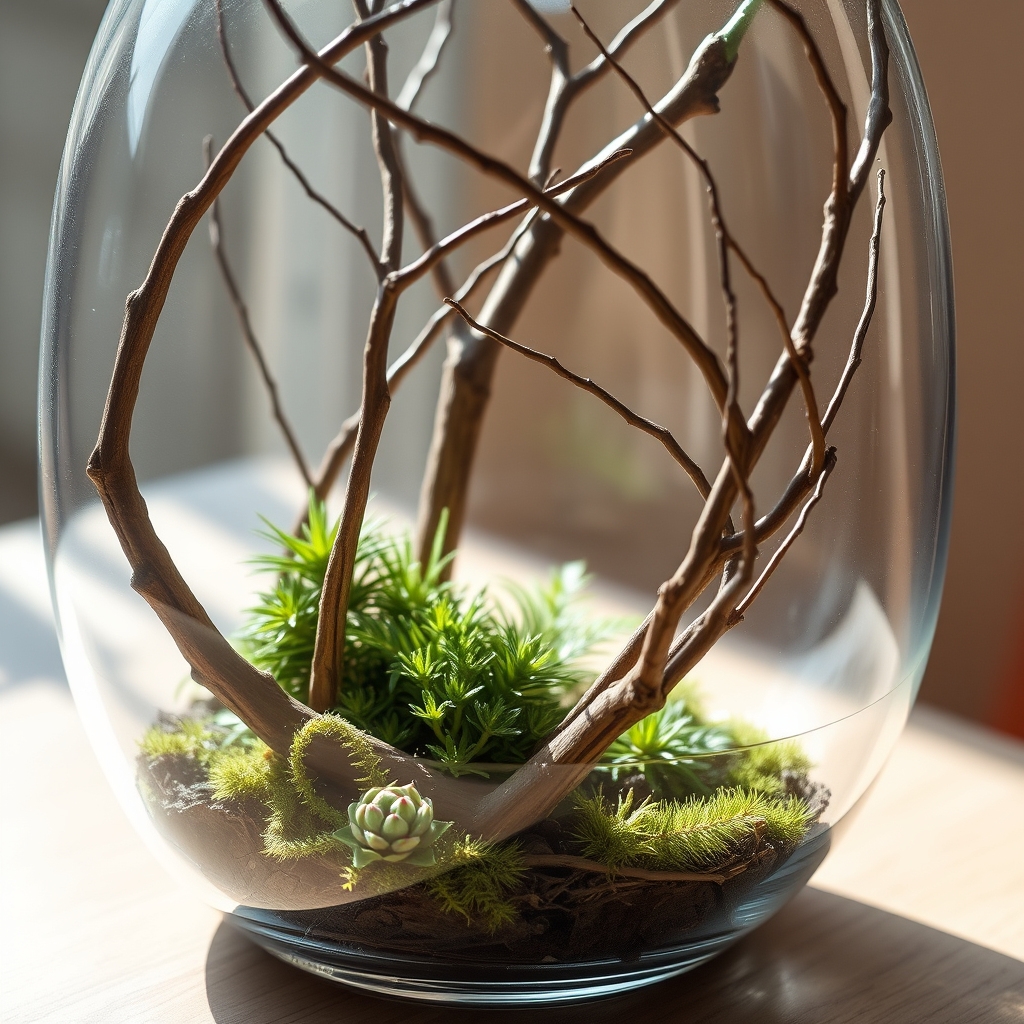
Twigs and branches are excellent natural elements to incorporate into a terrarium, providing both structure and a realistic, woodland aesthetic. These materials can be used to create vertical interest, mimic natural habitats, and offer support for climbing plants or small decorations. By carefully selecting and placing twigs and branches, you can transform a simple glass container into a miniature forest or jungle scene that feels alive and dynamic.
When utilizing twigs and branches, make sure they are clean and free from pests or mold before adding them to your terrarium. You can collect them from your backyard or purchase pre-sterilized options from craft stores. Position larger branches as focal points or anchors to create a framework, then layer smaller twigs to add depth and texture. This setup not only enhances the visual appeal but also provides hiding spots for small creatures if your terrarium houses live inhabitants.
Additionally, twigs and branches can be paired with other natural elements like moss, rocks, or vines to create a cohesive look. For an extra touch of creativity, consider wrapping thin branches with fairy lights or attaching small air plants to them. This approach allows you to customize the structure to suit the theme of your terrarium, whether it’s a desert landscape or a tropical rainforest, making it a unique and personal piece of decor.
Design With Recycled Plastic Bottle Caps
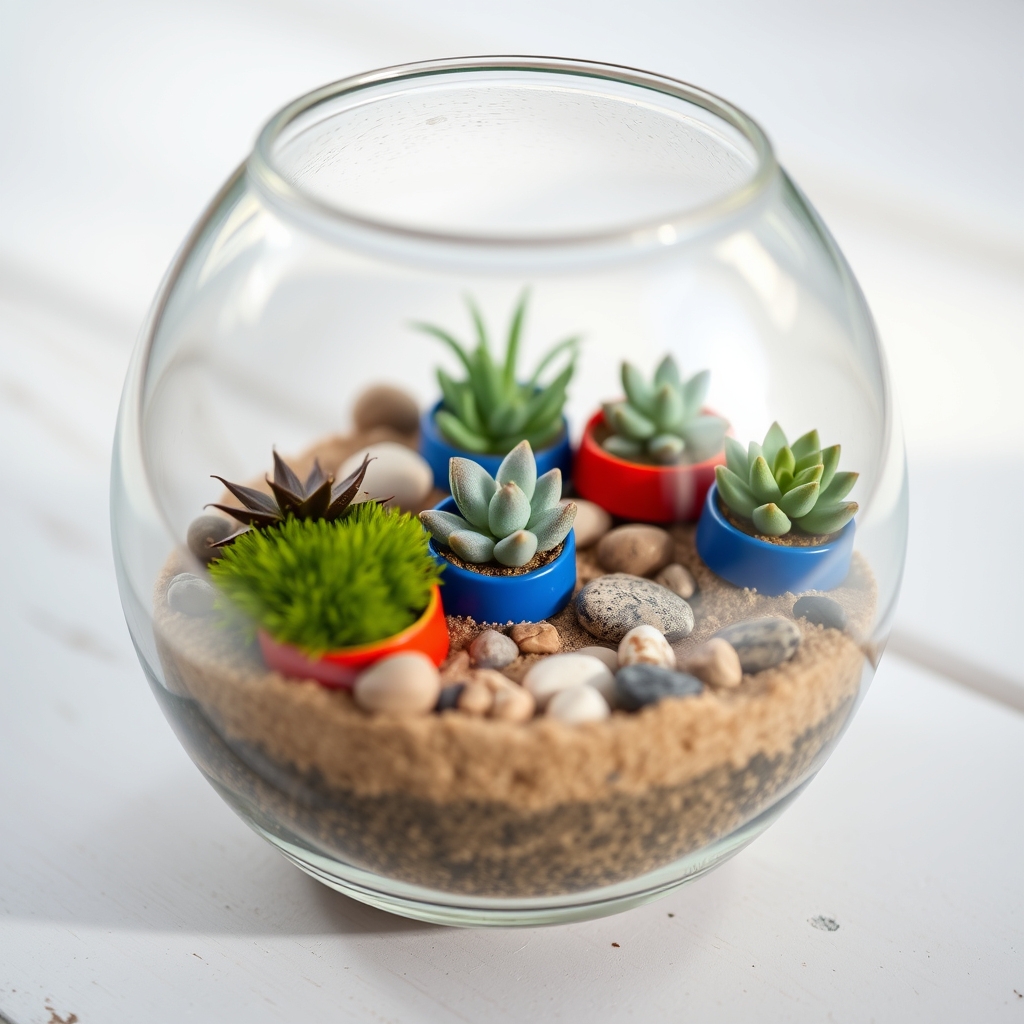
Designing a terrarium with recycled plastic bottle caps is a creative and eco-friendly way to add unique decor elements to your miniature ecosystem. Bottle caps, often overlooked as waste, can be transformed into colorful and functional pieces that enhance the aesthetic appeal of your terrarium. By collecting caps in various sizes and colors, you can create miniature structures, pathways, or even tiny containers for plants or decorative items within the terrarium.
To start, clean and dry the bottle caps thoroughly to remove any residue. You can use them as they are for a rustic look or paint them with non-toxic, water-resistant paint to match your terrarium’s theme. Arrange the caps to form small platforms, borders, or even stack them to create tiny “pots” for moss or small succulents. This not only adds a pop of color but also helps in organizing the space within the terrarium.
Additionally, bottle caps can be glued together to form larger designs, such as a mosaic base or a small fence around specific plants. This method allows you to repurpose materials that would otherwise be discarded, contributing to a sustainable crafting practice. With a bit of imagination, recycled plastic bottle caps can become an integral part of your terrarium’s charm, blending functionality with an environmentally conscious approach.
Enhance With Handmade Paper Cutouts
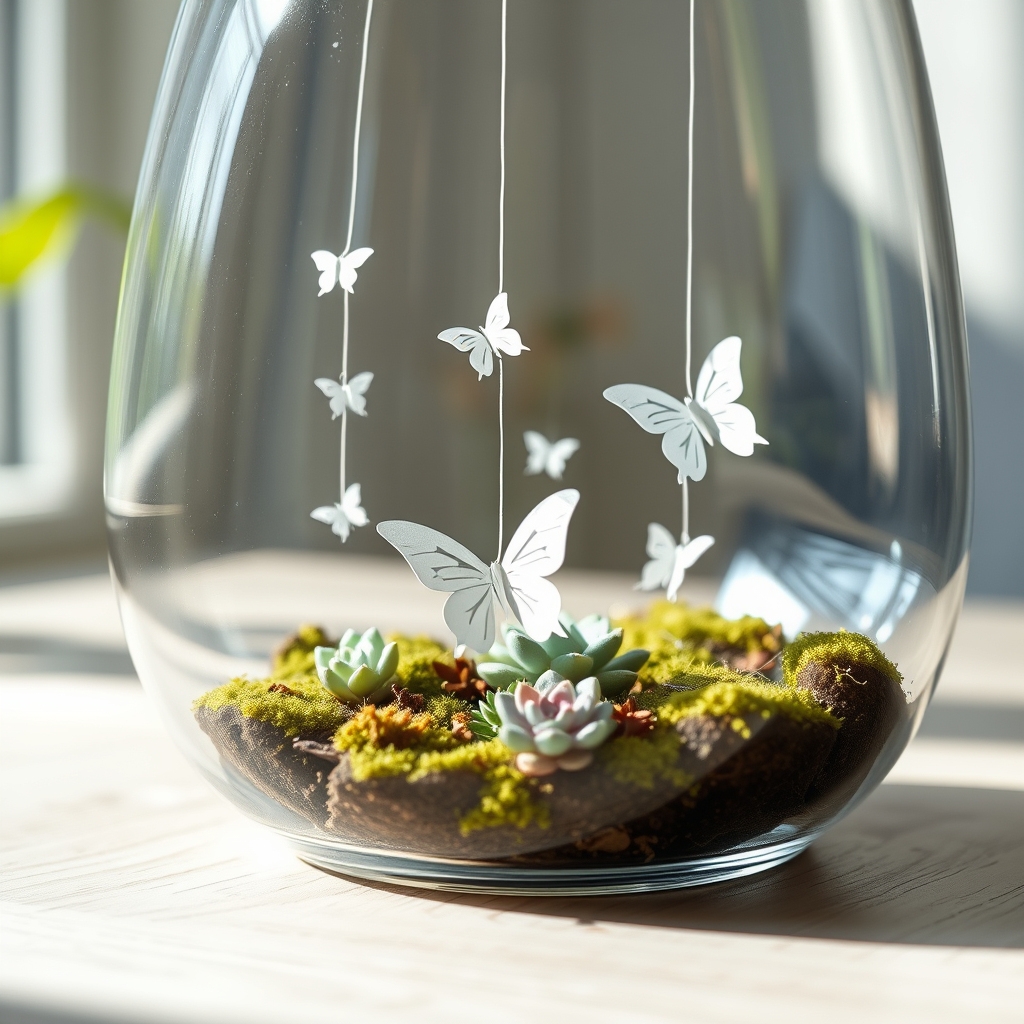
Adding handmade paper cutouts to your terrarium is a creative and personal way to enhance its visual appeal. These delicate designs can mimic natural elements like leaves, flowers, or even small animals, bringing a whimsical touch to the miniature ecosystem. By crafting your own cutouts, you can customize the shapes, colors, and themes to match the overall aesthetic of your terrarium, whether it’s a lush forest, a desert landscape, or a tropical jungle.
To create these cutouts, start with simple materials like colored paper, scissors, and a craft knife for intricate details. Sketch your desired shapes lightly with a pencil before cutting to guarantee precision, or use stencils for consistent designs. Once cut, you can attach the paper elements to the inside of the glass using small dabs of glue or double-sided tape, or suspend them with thin wire for a floating effect. This method allows for easy updates or seasonal changes, keeping your terrarium fresh and engaging.
Handmade paper cutouts also offer an opportunity to add storytelling elements to your terrarium. For instance, you could create a tiny scene with paper figures of fairies, woodland creatures, or cultural symbols that resonate with you. This personal touch not only elevates the decor but also makes your terrarium a unique reflection of your creativity and personality.
Highlight With Affordable Fairy Lights
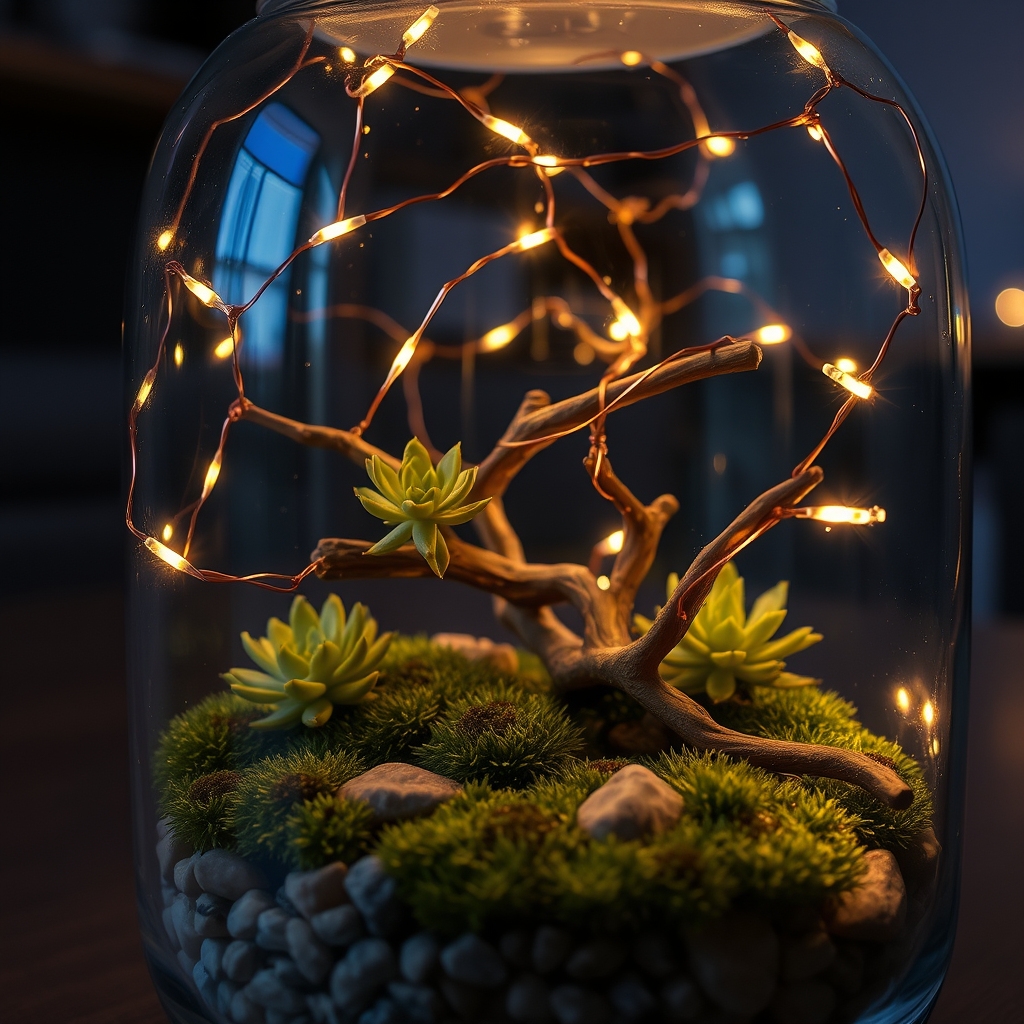
Fairy lights are a fantastic and affordable way to add a magical touch to your terrarium. These delicate, twinkling lights can transform a simple glass enclosure into a whimsical miniature world, highlighting the beauty of your plants and decor. Available in various colors and styles, fairy lights are easy to find at craft stores or online, making them a budget-friendly option for terrarium enthusiasts looking to elevate their designs.
To incorporate fairy lights, simply drape or weave them through the plants and decorations inside your terrarium, ensuring the battery pack or plug is discreetly placed for a seamless look. Opt for battery-operated lights to avoid messy cords, and choose warm white or soft pastel tones for a cozy, enchanting glow. This subtle illumination not only enhances the visual appeal during the day but also creates an enchanting ambiance at night.
Experiment with placement by wrapping the lights around branches, rocks, or even small figurines to draw attention to specific elements within your terrarium. Fairy lights are versatile and can be easily repositioned, allowing you to refresh the look of your terrarium without much effort or expense. This simple addition can make your miniature ecosystem feel like a glowing, magical escape.
